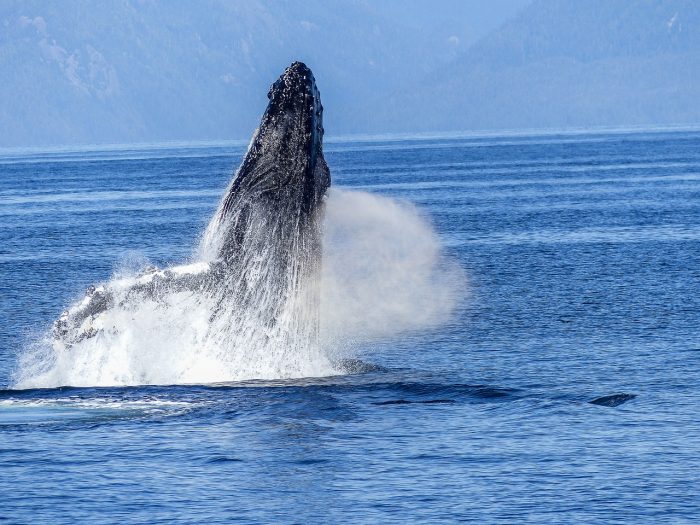Between You and Me: Diver swallowed by humpback whale and lives to tell the tale
By Leah S. Dunaief

Big mammals must appeal to me. I love horses. When I visited South Africa, I fell in love with elephants. And now that I have returned from a few days on Cape Cod, I am totally smitten by whales.
It was my first whale watch foray. We boarded a ferry-size boat in Provincetown, off the eastern tip of the Cape, and I was surprised to see at least 200 people, who had the same idea, seated on two decks. It was a perfect day to be out on the water, hot, humid, with only a soft breeze barely stirring the ocean. We finally found seats in a shaded section of the upper deck just as the boat took off heading north east into the Atlantic.
Everyone seemed in a holiday mood, talking and laughing for over an hour until someone yelled, “Look! There are mists ahead.” Then silence, as everyone peered at the horizon. The captain slowed the boat and as we got closer, we could see the backs of two whales, diving and surfacing, expelling air through their blowholes as they breathed.
“Those are humpbacks,” the tour guide explained over the PA system. “There are many different kinds of whales,” she continued. It seems there are about 80 species of living whales, and they fall into two groups: baleen and toothed. We were seeing baleens, a word that refers to the manner in which they secure their food. Instead of teeth, baleens are like broad vertical Venetian blinds that grow down from the roof of the whale’s mouth. They are hard, like our finger nails, each one at least a foot long, maybe five inches wide and close together. They act to filter what the whale takes in, excluding anything wider than plankton.
Two years ago, around this time, a whale swallowed a man just off the Cape. This is a true story that made headlines all over the globe, and the man, Michael Packard, lived to tell the tale.
“I’m done! I’m dead!” was the immediate reaction of Packard, who is a lobster scuba diver, when he was sucked into the mouth of a whale that came up behind him as he was descending to the seabed to search for lobster. Whales feed by opening their mouths like a wide elevator door, squeezing whatever is ingested, then spitting out what doesn’t get filtered by their baleen.
Suddenly he felt a huge shove and it got completely black, and Packard realized he was inside a whale. “ I could feel the whale squeezing with the muscles of his mouth,” said Packard, as quoted by Newsweek. “I thought to myself, ‘there’s no way I’m getting out of here.’”
But then the whale “started going up. All of a sudden it just got to the surface, and he started shaking his head and getting all erratic … and then boom!” The diver flew out of the whale’s mouth, traveled a distance of some 50 feet and lay floating on the surface, looking up at the sky. “I think I’m going to live,” he remembers. He was inside the whale for about 40 seconds. Packard was picked up by a crew member, who called to shore, and when they arrived at the pier, an ambulance was waiting to take him to the hospital. He wound up with one broken rib and some soft tissue damage. Three weeks later, he was back diving for lobsters but now also making TV appearances with the likes of Jimmy Kimmel.
Actually, the whale didn’t swallow Packard. A whale’s throat is too narrow for a human to pass through. The humpback held Pachard in his mouth, then surfaced and spit him out.
We were lucky on that trip, seeing 18 whales, according to the tour guide’s count. Once the boat stopped, the whales surfaced and dived around us, almost as if they were entertaining us. One whale, estimated by the captain to be about 6 months old, cavorted and flipped not far off the starboard side of our boat for at least 15 minutes. Some of us believe he was encouraged by our screams of approval and deliberately putting on a show.







